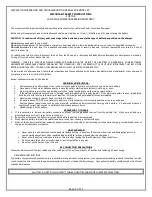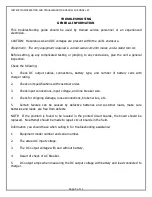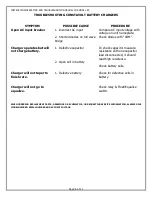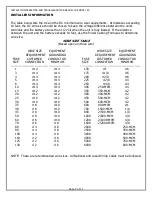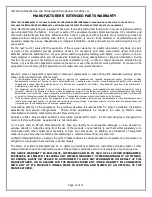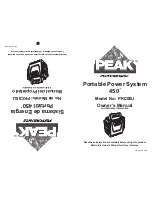
INSTRUCTION/OPERATING AND TROUBLESHOOTING MANUAL FOR MODEL EC
Page 4 of 11
INSTALLATION AND OPERATING INSTRUCTIONS
The EC Battery Charger is designed to operate on a specific number of battery cells. The
nameplate indicates the type and the number of battery cells required. Once properly installed,
the charger will maintain the battery in a fully charged condition. Install the charger so that the
flow of air through the ventilators is not obstructed. Dress field wiring circuits at least 1/4 inch
away from input/output circuits. When hooking up the DC cables to the battery be certain the
positive terminal of the charger is connected to the positive battery terminal and the negative
terminal is connected to the negative of the battery. Check the AC input voltage with voltage on
nameplate. If unit does not start re-set AC breaker.
After the charger has been installed, check battery specifications. When the battery is in a fully
charged condition, the float voltage should average 2.17 +.05 volts per cell for lead acid cells, 1.43
+.01 volts per cell for nickel-cadmium cell. The equalize voltage should average 2.32 +.05 volts
per cell lead acid cell, 1.55 +.02 volts per cell equalize nickel-cadmium cell.
The charger is factory tested and preset so that no field adjustments are necessary.
In normal operation, the EC Charger maintains a constant battery voltage. If the battery is
discharged, the charge will recharge the battery on a taper curve from its current limiting capacity
to full charge. No permanent loads should be connected to the battery.
The Float/Equalize Switch is used to raise the charger output voltage to 2.32 +.05 volts per cell for
lead acid cells or 1.55 +.02 volts per cell for nickel-cadmium cells, so that the battery can be given
an equalizing charge. To give an equalizing charge, it is only necessary to throw the switch to the
equalize position and leave it there for 24 hours. The charger will hold the cell voltage at the
equalizing voltage while the switch is in equalize position and will drop back to float voltage when
the switch is put back into the normal or float position.
LED’s indicate the equalize or float mode.
The inherent design of the ferroresonant transformer compensation for line voltage variations of
+ 10%.
The DC output current is limited to provide for complete protection. The current limiting feature
allows for the unit to carry overloads and limits the output to a maximum of less than 150% of the
rated output.
NOTE: This unit is
not
recommended for use on sealed valve regulated batteries.


